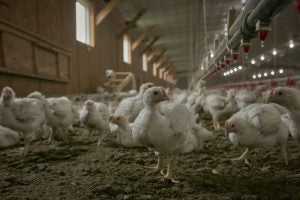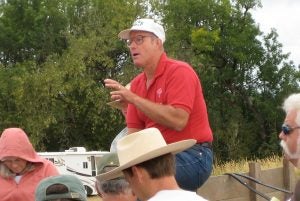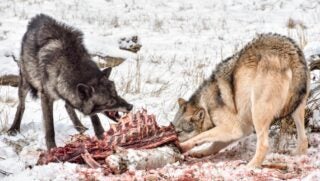The agriculture industry got it’s Joe Rogan Experience when Joel Salatin, the activist farmer who proudly stated on his blog recently that he wanted to contract COVID-19, was a guest on the podcast on May 20. Not surprisingly, the conversation was a narrow and one-sided perspective on agriculture, and it would have been more valuable and ethical for Rogan to have welcomed producers from different backgrounds to discuss the issues at hand in a fair light, rather than relying on a controversial figure who represents a tiny minority of our industry.
If you ever had to see Food, Inc. or read The Omnivore’s Dilemma, you might recognize Salatin’s name — he was famously featured in both. Additionally, he runs his family’s farming business, Polyface Farms, a small Virginia agricultural operation that strives to be a regenerative, natural farm, and a “clean meat connection.”
The conversation between Rogan and Salatin begins with the COVID-19 crisis and how it has negatively affected the food and animal industry, then quickly lashes out against the “mega system that’s cracking” — Salatin’s reference to large processing facilities’ issues during the pandemic.
For someone like Salatin who has spent years (or even decades) honing his brand and his message, it was surprising to see him fumble through some of the points he was trying to make during the podcast. I don’t mean to say that to be mean or intend it as a dig at the farmer, but it didn’t create reassurance in me that he was confident, or sure of what he was saying. This laid the foundation for the mood of the entire podcast.
And, for someone like me who has experienced the wide diversity of American agriculture, both in the plant and animal sectors, it got worse from there. The podcast runs a whopping two hours and 37 minutes, so I’m not going to detail every issue discussed on the show; rather, I hope to help tell the other side of the story, the one that Rogan doesn’t invite onto his show, pertaining to some of the more hot-button topics.
First, Salatin discusses the advantages he perceives of having many smaller processioning facilities versus having a few larger ones.
“Wouldn’t it be an amazing thing if instead of having a 150 to 200 mega-processing facilities doing 98 percent of the nation’s meat, that there were 200,000 small-scale community-based ecologically nested facilities, you know all around the countryside. That would be an incredibly resilient system.”
This argument has been rebuked by industry experts, who disagree about whether it would solve the beef industry supply problem. While this is a highly controversial topic that I feel is too emotionally driven to discuss at length in this article (it would require an article all its own), there are many factors to consider when discussing the addition of smaller processing plants, including capacity, custom-exempt status, and being able to provide meat across state lines in order to feed the amount of people that are fed with our larger, highly efficient processing plants.
However, it’s what Rogan responds back to Salatin that is a deep cause for worry of this podcast.
“It sounds like a much better system, like as you were talking before about your relationship with your customers, it’s a direct-to-farm,” Rogan said. “I mean that’s really ideal right? Cut out the middle person, cut out the confusion, whether or not the animals are ethically raised or ethically slaughtered. You do regenerative farming — you let these animals live the way these animals are supposed to live. They’re not confined to cages, they’re roaming around, they’re eating natural foods, and you get a better product. You get a healthier product, and get a better relationship with both the animals, and the people that you sell this food to.”
Large processing facilities are regulated, inspected, and overseen by government organizations to ensure animal welfare is followed to a “T,” and that all meat is healthy and safe from foodborne pathogens. It’s a centralized system that works toward continuous improvement in food safety standards, with the manpower and technological opportunities to enforce those standards.
The Federal Meat Inspection Act requires facilities to follow strict guidelines: “The Federal inspection personnel must be present at all times during livestock slaughter operations and for at least part of each shift during which there is further processing of meat products. In slaughter plants, inspection personnel verify the humane handling of animals and conduct antemortem inspection to ensure that the live animal is fit for slaughter. These inspection personnel also conduct post-mortem inspection to ensure that the meat from the carcass and internal organs are fit for human food.”
The Humane Slaughter Act is another protection put into place that ensures animals are treated ethically throughout processing.
“Meat plants that handle and slaughter live animals are the most regulated and inspected industry in America,” it says. “Federal Humane Slaughter Act regulations are enforced by USDA’s Food Safety and Inspection Service (FSIS) and specify the proper treatment and humane handling of livestock slaughtered in USDA-inspected slaughter plants. The law’s provisions are numerous and include requirements that livestock be handled calmly with minimal excitement, that they never be dragged, that objects that cause unnecessary pain not be used to drive livestock, that water be provided in holding pens at all times, that feed be provided if an animal is at a plant more than 24 hours, and that livestock be rendered completely unconscious prior to slaughter. Federal inspectors are present at all times in plants that handle live animals and are empowered to take actions for compliance failures, including stopping production and even withdrawing inspection in extreme cases.”
Livestock are raised to ensure they are high-quality, high-producing animals. Abuse, and unethical treatment of animals will lower the quality of the product. Farmers and ranchers often receive training, like through the Beef Quality Assurance or Pork Quality Assurance programs, that educate them on the proper handling of animals to ensure livestock are given the most ethical treatment. For more information on different sectors, like turkey, egg and sheep, head to the Animal Agriculture Alliance page.

Elsewhere in the podcast, Salatin’s statement about animals in cages is an ignorant comment that doesn’t consider the biosecurity and health benefits of livestock housing. For example, the National Chicken Council notes that broilers are raised in large, open structures known as growout houses.
“These houses are well-equipped with mechanical systems to deliver feed and water to the birds and have environmental systems to provide a comfortable and protective environment, including ventilation systems and heaters that function as needed, most often with micro-processor controls. Keeping birds inside a house protects them from predators such as hawks and foxes. Some houses are equipped with curtain walls, which can be rolled up in good weather to admit natural light and fresh air. In that case, a fine mesh screen keeps insects, rodents and wild birds out of the house and away from the broilers. Such biosecurity measures are critical to ensuring the health of the flock.”
Cattle are also kept on vast, open land for most of their lives — the production distinction listed on food labels really is more about being grain- or grass-finished, since cattle typically graze on grass most of their lives regardless. Even then, there’s no nutritional difference between the two methods. Once cattle, which are meant for meat processing, are sent to the feedlot, they are in large pens, which allow for daily health checks, and nutritious feed.
“Feedlots allow for the efficient raising of beef utilizing fewer natural resources like land, feed and water,” according to the Kansas Livestock Association. “And ‘crowding’ is a common misperception. Feedlots provide an average of 125 to 250 square feet per animal, providing plenty of room for cattle to run, stretch and lay down. Feedlot cattle often intentionally ‘crowd’ themselves together in one corner of the pen. This behavior is normal for herd animals like cattle.”
Salatin affirmed all Rogan’s perceptions, stating, “Ultimately, what we’re looking for is a habitat that allows, you know, expressing the pigness of the pig, or the chickeness of the chicken, you know, and creating a habitat that allows that life to express its phenotypical and physiological distinctiveness.”
He then brings up antibiotic use and how we have made superbugs with our unnatural use of them in the food supply, despite recent data published in The Lancet Infectious Diseases journal conflicting with his claims.
“We’ve used antibiotics in animals and made MRSA, and C. Diff and superbugs,” he argued. In somewhat rambling fashion, Salatin continued, “We simply don’t listen and continue to pummel,” which leads into him discussing how large processing facilities are breeding grounds for virus spread.
However, the journal research on antibiotic-resistant E. coli superbugs, for example, which was released in 2019, explains that “human-adapted strains of ESBL-E. coli, principally ST131, which dwell in the gut and which occasionally — usually via UTIs — go on to cause serious infections. And that there are animal strains of ESBL-E. coli. But — and critically — there’s little crossover between strains from humans, chickens, and cattle. The great majority of strains of ESBL-E. coli causing human infections aren’t coming from eating chicken, or anything else in the food chain.”
In general, antibiotics are used to create healthier animals, alleviate suffering caused by illness, and are a great animal welfare tool. While antibiotic resistance has been a concern, the industry is constantly ensuring antibiotics are safe. Additionally, the expense of treating animals is high, and producers are careful not to overuse them; regulations enacted a few years ago require careful veterinary oversight.
A fact sheet from the Animal Ag Alliance states, “Animal antibiotics make our food supply safer and people healthier. Antibiotics are a critical tool to prevent, control and treat disease in animals. Banning or severely restricting the use of antimicrobials in animals may negatively impact a veterinarian’s ability to protect animal health and prevent suffering from disease, which can lead to poor animal welfare.”

Salatin explains that large poultry houses experience major losses of birds due to floods and heat waves, and that houses are not meant to protect birds. This is yet another claim of his that his highly disputed. One expert, Dr. Victoria Sandilands, has said that free-range birds have a mortality rate of 8 to 10 percent, compared with a rate of 2 to 4 percent for those kept indoors. Another animal expert, Barry Thorp of the Royal School of Veterinary Studies in Edinburgh, said chickens allowed to roam free in open fields typically die sooner and are much more likely to catch diseases, since they haven’t been bred for that kind of environment year-round.
Poultry houses are highly modernized pieces of equipment — they protect the birds, give them a higher quality of life, and provide ample space for birds to grow. While Salatin may be able to use herd geese as protection and the reflective parts of soda cans to disorient some predators, this doesn’t mean that large houses are not capable of providing the same protections on a more efficient and implementable scale.
Further into the podcast, he discusses exporting foods to other nations. He says that California could have enough food to feed its people, after Rogan asks if regenerative farming is a sustainable practice to feed Los Angeles. If California, for example, did not export almonds all over the world, if California is centered on feeding California, there’s absolutely enough here to feed California.”
The truth is, California produces about 80 percent of the world’s almonds and 100 percent of the U.S. commercial supply. We are able to provide plenty of food to our country, while also providing food to other countries, and add value to our agricultural products.
There are many topics discussed on the show between Rogan and Salatin. To me, the conversation seemed repetitive, inconclusive, and composed more of disjointed ideas rather than structured, well-educated thoughts. Rogan is a smart individual, and he normally does his research on topics of discussion, but he seems to miss the mark with Salatin. The entire podcast was full of sensationalized, controversial, and incorrect information, and the worry is that the exposure The Joe Rogan Experience receives, as one of the top podcasts in the nation, will further drive the idea that large operations are bad and unhealthy.
There is room in agriculture for all kinds of practices, and one is not necessarily worse than the other. There are good people who farm big and small, and there are bad people on those ends, too. What people of influence, like Rogan, should do, is provide a balanced and fair discussion between producers and industry professionals to prevent bias. Perhaps, instead of going to Joe Rogan, I can hope that people get out onto an actual farm or ranch to see what the real experience is like.
Markie Hageman lives in California and is an agribusiness graduate from Fort Hays State University. She is the Communications Coordinator for California Rangeland Trust and is an avid agriculture advocate. Her AGDAILY articles can be found here.



